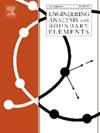Deep-neural-network-based framework for the accelerating uncertainty quantification of a structural–acoustic fully coupled system in a shallow sea
IF 4.2
2区 工程技术
Q1 ENGINEERING, MULTIDISCIPLINARY
Engineering Analysis with Boundary Elements
Pub Date : 2025-02-01
DOI:10.1016/j.enganabound.2024.106112
引用次数: 0
Abstract
To systematically quantify certain uncertainties within the vibro-acoustic coupling problems, we propose a framework for sampling the acceleration and uncertainty quantification based on a Deep Neural Network (DNN). Coupling the Finite Element Method (FEM) and Boundary Element Method (BEM) with Catmull–Clark subdivision surfaces to generate samples for DNN training and testing. Constructing various DNN surrogate models with different input dimensions to generate abundant samples for uncertainty quantification. Applying a highly structured neural network Stochastic Differential Equation Network (SDE-Net) for uncertainty quantification using these samples. Numerical examples are implemented to verify the validity and effectiveness of the proposed algorithm. The main results are as follows: The numerical results match well with the analytical results, indicating that the FEM–BEM can accurately solve the fully coupled structural–acoustic system and provide high-quality initial samples for the DNN; The statistical metrics of DNN testing results demonstrate extremely high prediction accuracy; The proposed uncertainty quantification framework offers a time advantage and potential for dealing with more complex physical problems.
基于深度神经网络的浅海结构声全耦合系统不确定度加速量化框架
为了系统地量化振动声耦合问题中的某些不确定性,我们提出了一个基于深度神经网络(DNN)的加速度采样和不确定性量化框架。将有限元法(FEM)和边界元法(BEM)与Catmull-Clark细分曲面耦合,生成用于深度神经网络训练和测试的样本。构建不同输入维数的DNN代理模型,生成丰富的样本进行不确定度量化。应用高度结构化的神经网络随机微分方程网络(SDE-Net)对这些样本进行不确定性量化。通过数值算例验证了该算法的有效性。主要结果如下:数值结果与解析结果吻合较好,表明有限元-边界元法能够准确求解结构-声全耦合系统,为深度神经网络提供高质量的初始样本;DNN测试结果的统计指标显示了极高的预测精度;所提出的不确定性量化框架为处理更复杂的物理问题提供了时间优势和潜力。
本文章由计算机程序翻译,如有差异,请以英文原文为准。
求助全文
约1分钟内获得全文
求助全文
来源期刊

Engineering Analysis with Boundary Elements
工程技术-工程:综合
CiteScore
5.50
自引率
18.20%
发文量
368
审稿时长
56 days
期刊介绍:
This journal is specifically dedicated to the dissemination of the latest developments of new engineering analysis techniques using boundary elements and other mesh reduction methods.
Boundary element (BEM) and mesh reduction methods (MRM) are very active areas of research with the techniques being applied to solve increasingly complex problems. The journal stresses the importance of these applications as well as their computational aspects, reliability and robustness.
The main criteria for publication will be the originality of the work being reported, its potential usefulness and applications of the methods to new fields.
In addition to regular issues, the journal publishes a series of special issues dealing with specific areas of current research.
The journal has, for many years, provided a channel of communication between academics and industrial researchers working in mesh reduction methods
Fields Covered:
• Boundary Element Methods (BEM)
• Mesh Reduction Methods (MRM)
• Meshless Methods
• Integral Equations
• Applications of BEM/MRM in Engineering
• Numerical Methods related to BEM/MRM
• Computational Techniques
• Combination of Different Methods
• Advanced Formulations.
 求助内容:
求助内容: 应助结果提醒方式:
应助结果提醒方式:


